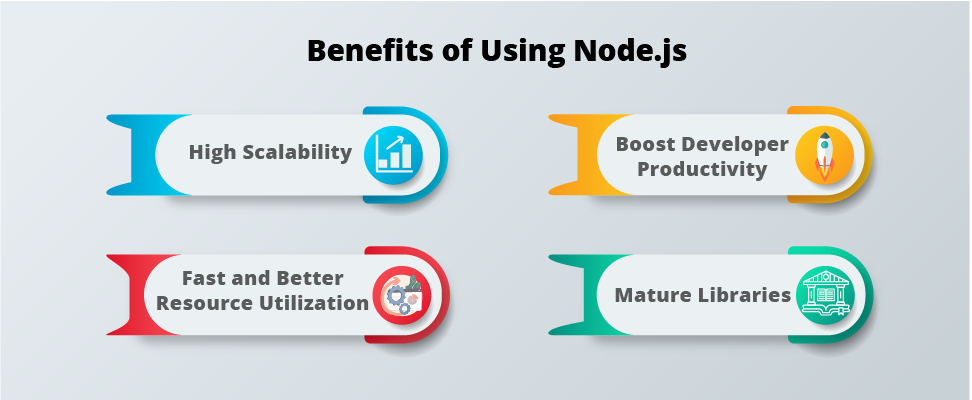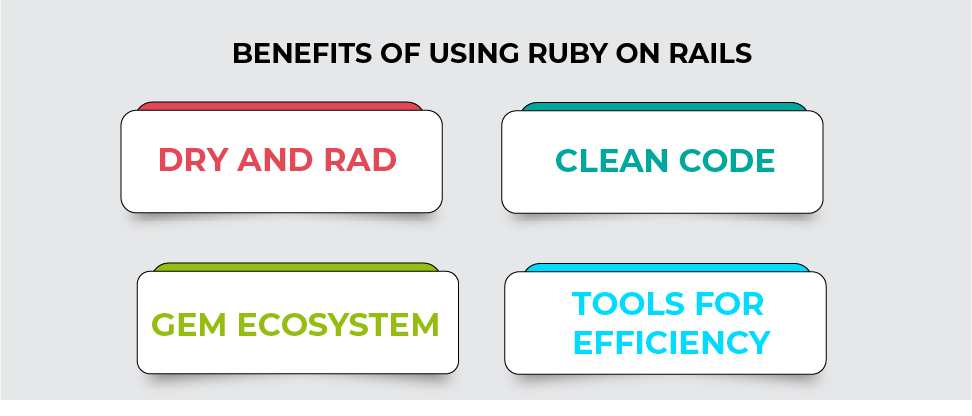Table of Contents
ToggleIntroduction
Node.js is a JavaScript runtime environment that enables JavaScript to write client-side and server-side code, and Ruby on Rails (RoR) is a full-stack framework for Ruby. So, comparing Node.js and Ruby on Rails is like comparing the moon to the sun. These two popular technological stacks have gained a lot of traction in today’s market. In this article, we will explore the difference between Ruby on Rails and Node.js by going through the benefits and use cases.
Understand the Difference Between Node.js and RoR
Node.js is a runtime environment built on the Google Chrome V8 Engine. It translates JavaScript into machine code and is widely used in backend development. Node.js framework plays a crucial role in the JavaScript ecosystem. Its built-in Node Package Manager (npm) library is one of the most popular package libraries. Node.js is best for event based, I/O, and non-blocking applications.
RoR, on the other hand, is a framework for website development renowned for its clear, concise, and flexible syntax that is akin to the English language. Rails helps developers manage internal logic, routines, and data computing. Moreover, it is ideal for all database-backed web apps.

Don't miss out on your chance to work with the best
apply for top global job opportunities today!
Why Use Node.js?
Node.js’ lightweight, non-blocking, event-driven approach to I/O and cross-platform support features made web development easier by using JavaScript, an open source programming language. The following are the benefits of using Node.js:

High Scalability: Node.js has exceptional scalability, which contributes largely to its popularity. Its lightweight development environment is a perfect match for the microservice architecture. It divides application logic into small microservices and modules and then simplifies the process of adding more microservices on top of the existing ones instead of integrating additional features with the basic app functionality.
Boost Developer Productivity: By using only one programming language, the web app development process is simple. Node.js developers can reuse code and not rely any more on additional technologies and resources. As a result, it allows faster development with enhanced efficiency.
Fast and Better Resource Utilization: Its asynchronous nature makes the Node.js application incredibly fast. The non-blocking I/O model handles numerous concurrent connections without any delay or performance lag. This feature enables the app to operate even on low-powered or resource-constrained devices. In addition, Node.js architecture is divided into two main components, i.e., the V8 engine and LIBUV. V8 Engine is a Node.js compiler that converts JavaScript code to machine code, and LIBUV is a library focused more on asynchronous I/O. This library provides Node.js access to a file system, an operating system, and networking.
Mature Libraries: Node.js, Express.js, and Koa.js are the core foundation for building robust and secure APIs quickly. It can also integrate well with popular front-end frameworks like React and Angular. This enables communication between the server and the client. Therefore, developing interactive and dynamic web applications becomes easy with simple data flow.
Must Read: WHAT IS NODE.JS? AND WHAT IS IT USED FOR?
Top Companies that use Node.js
The following are the top companies that use Node.js:

- NASA uses Node.js for the robust security of its data and to handle real-time data processing tasks.
- Netflix uses Node.js to manage its high-volume web streaming for its millions of users worldwide.
- Uber was developed using Node.js; it depends on asynchronous primitives and simple, single-threaded processing.
- LinkedIn switched from Rails to Node.js for its scalability and performance efficiency. Similarly, PayPal switched from Java and PayPal over to JavaScript for its backend server for web applications.
What are the Benefits of Using RoR?
Ruby on Rails Convention over configuration prevents the tedious tasks and apid MVP development allows developers to build database-backed applications with minimal configuration. Not only that, but it also cuts down the development time and effort and makes the processing time efficient. The following are the benefits of using RoR:

DRY and RAD: RoR follows the DRY principle which means RoR developers don’t have to write the code again and again for repetitive tasks. It can easily spot the monotonous function and let developers reuse those codes for unlimited time. This is something interesting and best right! RAD acronyms are for Rapid application development, which is another benefit of using Rails. It not only streamlines but also processes the transformation of accommodation.
Clean Code: Rails developers have the privilege of using ready-to-use components of code. This helps them to implement many useful features thus making your code highly readable. With minimal code to read and sort, updates are quick and straightforward. This in return makes the development with Rail cost-effective.
Gem Ecosystem: Rails developers have the luxury of utilizing RubyGems, which lets them integrate any third-party libraries and extensions into their applications. Gems libraries have a wide collection of functionalities that are essential for building any web application. It provides authentication and authorization from image handling to payment processing. So, what’s more by leveraging gems, developers can speed up the development and build amazing web applications.
Tools for Efficiency: RoR provides tools generators and scaffolding. This tool automates the common components like controllers, models, and views. In return, developers can build functional web applications with less time and quickly prototype ideas and features rapidly.
Top Companies that Use Ruby on Rails Web Framework
The following are some of the top companies that use Ruby on Rails web framework:

- Rails framework is the driving force behind the success of the popular app Airbnb. It is built upon using Ruby on Rails.
- Fiverr, a freelancing platform, has used Ruby on Rails since its inception, and it’s still running its online service marketplace successfully.
- GitHub has over 200 million code repositories and 32 million monthly users using Rails for the backend.
- Shopify, a popular e-commerce platform that has over 820,000 sellers using their service, is built using the Rails framework. It is a user-friendly yet sophisticated app.
Ruby on Rails vs. Node.js: A Glance at its Key Differences
| Factors | Node.js | Ruby on Rails |
|---|---|---|
| Deployment | Takes more time because developers must search for modules with proper instructions to integrate them into their apps | Migrating a database with few lines of command makes the process super-fast |
| Architecture | MVP and MVC architecture | Model View Controllers (MVC). |
| Execution | It has limitations due to the reliance on JavaScript | It has better execution |
| Page Load | Extremely fast | Slower than Node.js |
| Development | Used for both client-side and server-side | Backend (Server-Side) framework |
| Performance | Its performance is better than Rails | Rails may slow down during high traffic |
| Libraries | Node Package Manager (NPM) offers packages and libraries | Ruby Gems |
| Scalability | Better than Rails | Can scale up but developers need to invest maximum resources |
| Web Server | Manages all the HTTP request | It relies on NGINX, Apache, WEBrick, and Cherokee |
| Strength | Minimal code and ease of deployments | Exceptional page loading time and super flexible |
| Installation | Quite easy to install | Need to add generators which take quite a lot of time |
| Best Recommended | To build a lightning-fast application | Complex and large-scale application |
| Startups | Difficulty in managing the security model makes it incompatible | Rails are the perfect solution |
| Market Demands | Its market and user base are growing exponentially | Comparatively less popular than Node.js |
Conclusion
Node.js and Ruby on Rails are robust frameworks for building websites and apps. Node.js is best for developing real-time applications with many concurrent requests because it is a non-blocking, event-driven server with push-based architectures. Plus, there is no hassle switching between different programming languages. Using JavaScript, developers can create both the front and back end of apps. However, if you need to create an application like a social networking site or an e-commerce platform that requires high performance, Ruby on Rails is the perfect option for you. Moreover, Ruby on Rails is also ideal for creating CPU-intensive tasks and rapid application development. Therefore, before you pick one technology, weigh the benefits and consider the development team’s preferences. If you’re a web developer and looking for an amazing opportunity in an esteemed organization, then sign up with Olibr.
Take control of your career and land your dream job
Sign up with us now and start applying for the best opportunities!

FAQs
Node.js outperforms Ruby on Rails in terms of performance; if you’re building applications that require high performance, Node.js is the ideal choice. Likewise, Ruby on Rails is undeniably the better choice for CPI-intensive activities.
Yes, Node.js is designed to handle large-scale applications, especially ones that require real-time updates and frequent data communication.
You can go for Node.js if you want to build blazing-fast and scalable applications.
Node.js is faster than Ruby on Rails as it is built upon the Google V8 machine, and other features like single-threaded and event loops contribute to its speed.
Ruby on Rails is best suited for building modest web applications for small IT businesses and start-ups.
Node.js is primarily used for web development. But it can used for creating desktop applications and IoT devices.
In Node.js, a function is used to process the incoming request and handle the outgoing responses between the client and the server. But this function settles between the final destination and the initial request; therefore, it is called middleware.
- First, you need to create an index page, copy the code from this official website, and paste it in your file.
- Replace the connection string placeholder with the connection string provided in this guide.
- Run this command: node index.js to start the application.
- Once completed, you can connect MongoDB with Node.js.

